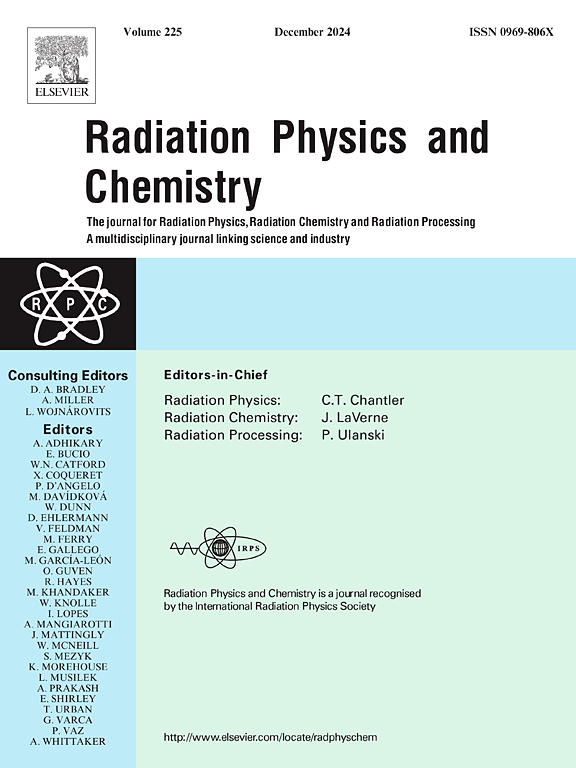利用含羞草树皮提取物绿色合成氧化锌颗粒并实现热发光响应
IF 2.8
3区 物理与天体物理
Q3 CHEMISTRY, PHYSICAL
引用次数: 0
摘要
工业活动的持续增长导致了环境退化,这凸显了为社会创造技术解决方案而采用替代性环保化学方法的必要性。绿色合成为大规模生产多种应用材料提供了一种前景广阔的方法。本文提出了一种利用含羞草树皮提取物合成氧化锌(ZnO)颗粒的绿色方法,以评估在不同煅烧温度(400 °C、700 °C和1000 °C)下生成材料的热致发光(TL)响应。通过 X 射线衍射 (XRD)、扫描电子显微镜 (SEM)、X 射线荧光 (XRF)、紫外可见 (UV-vis) 光谱和热致发光 (TL) 测量,对制备的材料进行了评估。氧化锌粉末显示出单相钨锌氧化物的六方晶胞晶系,结晶尺寸受煅烧温度的影响。制备了 ZnO/Teflon® 颗粒,以评估在 10 Gy 至 300 Gy 的 90Sr β 辐射源辐照下的 TL 响应。在 400 和 700 °C 下煅烧的样品未显示出 TL 反应,而在 1000 °C 下煅烧的样品则显示出强烈的 TL 信号,在 308 °C 下有一个突出的峰值,并在 10-300 Gy 的范围内呈线性增长,这加强了 ZnO-1000/Teflon® 颗粒在 TL 剂量测定中的应用前景。本文章由计算机程序翻译,如有差异,请以英文原文为准。
Green synthesis and thermoluminescent response of ZnO particles using Mimosa tenuiflora bark extract
The continuous growth of industrial activity has led to environmental degradation, highlighting the need for alternative and environmentally friendly chemical methods for creating technological solutions for society. Green synthesis offers a promising approach for the large-scale production of materials for several applications. Herein, the synthesis of zinc oxide (ZnO) particles is proposed by a green route using Mimosa tenuiflora bark extract for evaluation of the thermoluminescent (TL) response of the produced material at different calcination temperatures (400 °C, 700 °C, and 1000 °C). The resulting material was evaluated from X-ray diffraction (XRD), scanning electron microscope (SEM), X-ray fluorescence (XRF), UV–visible (UV–vis) spectroscopy, and thermoluminescence (TL) measurements. The ZnO powder exhibited a single-phase wurtzite ZnO with a hexagonal unit cell crystal system with the crystallite size affected by the calcination temperature. ZnO/Teflon® pellets were prepared to assess the TL response under irradiation with a90 Sr beta radiation source between 10 Gy and 300 Gy. The samples calcined at 400 and 700 °C did not show a TL response, while the samples calcined at 1000 °C exhibited an intense TL signal, with a prominent peak at 308 °C and a linear growth in the range of 10–300 Gy, reinforcing the perspectives for use of ZnO-1000/Teflon® pellets in TL dosimetry.
求助全文
通过发布文献求助,成功后即可免费获取论文全文。
去求助
来源期刊

Radiation Physics and Chemistry
化学-核科学技术
CiteScore
5.60
自引率
17.20%
发文量
574
审稿时长
12 weeks
期刊介绍:
Radiation Physics and Chemistry is a multidisciplinary journal that provides a medium for publication of substantial and original papers, reviews, and short communications which focus on research and developments involving ionizing radiation in radiation physics, radiation chemistry and radiation processing.
The journal aims to publish papers with significance to an international audience, containing substantial novelty and scientific impact. The Editors reserve the rights to reject, with or without external review, papers that do not meet these criteria. This could include papers that are very similar to previous publications, only with changed target substrates, employed materials, analyzed sites and experimental methods, report results without presenting new insights and/or hypothesis testing, or do not focus on the radiation effects.
 求助内容:
求助内容: 应助结果提醒方式:
应助结果提醒方式:


